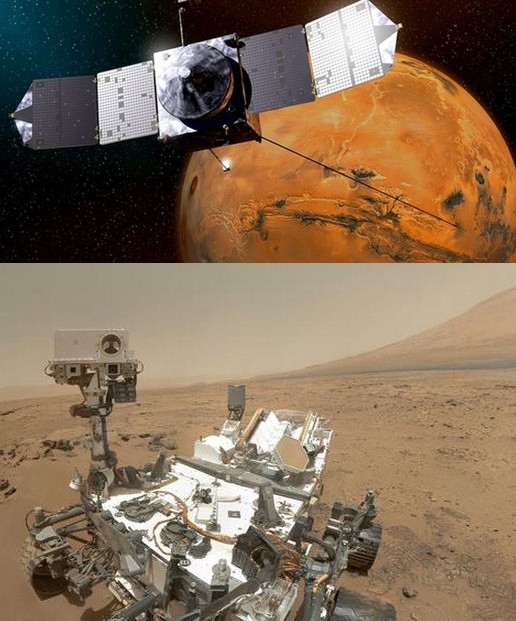Since late-2014, the team-up between NASA's Curiosity Mars Rover on the surface and the MAVEN spacecraft orbiting the Red Planet is telling scientists what on Earth happened to Mars' atmosphere and water and what lessons we can learn from this planetary disaster.
MAVEN or the Mars Atmosphere and Volatile EvolutioN mission (MAVEN) entered Martian orbit on Sep. 21, 2014. Its mission is to characterize the current state of Mars' weak upper atmosphere and ionosphere and determine the rate of gas loss.
MAVEN is researching the historical loss of Martian water and carbon dioxide into space. It's studying the whole region from the top of the upper atmosphere down to the lower atmosphere so the connection between the two can be better understood.
Its primary mission includes five "deep-dip" campaigns in which the altitude of MAVEN's orbit will be lowered to about 125 km (77 miles) to pass it through both atmospheric regions. The first deep-dip campaign ran from Feb. 10 to 18 at the top of the atmosphere.
MAVEN isn't working alone in the quest to find out about Mars' atmospheric history. Its other "Splash Robot Brother", Curiosity, is blazing a trail on the Martian surface doing the same thing.
Surface data from Curiosity and MAVEN's measurements of Mars' atmosphere allow researchers to reconstruct a history of the Martian atmosphere -- including the rate at which the planet has lost water-- over its 4.6 billion-year history.
Both Splash Robot Brothers are also looking for water, the key ingredient for the emergence of organic life.
With its current drilling and experiments, Curiosity is trying to determine if water ever collected in Gale Crater. On the other hand, MAVEN is trying to find the answer to the question, "Where did any surface water go"?
Mars' atmosphere is thin, or one percent as dense as Earth's atmosphere. How did this happen?
"Without going and measuring what's actually happening, you can't have any hope of understanding" the unique mix of factors that turned Mars from what many scientists believe was a wet, warm planet early in its history to the dry, radiation-bathed surface the planet presents today, said Dr. Bruce Jakosky, the mission's lead scientist and a researcher working at the interface of planetary geology and astrobiology at the University of Colorado at Boulder.
That's why the team-up between Curiosity and MAVEN is so important.
Curiosity landed on Mars on Aug. 6, 2012. Its goals include investigating the role of water in creating an environment conducive to microbial life; conducting planetary habitability studies in preparation for future human exploration and investigating Martian climate and geology.
The cooperation of both these robots reminds one of the real "Splash Brothers", Stephen Curry and Klay Thompson of the NBA team, the Golden State Warriors that lead the current 2014-2015 NBA season with the most number of wins.


